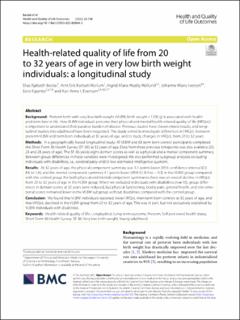| dc.contributor.author | Berdal, Elias Kjølseth | |
| dc.contributor.author | Wollum, Arnt Erik Karlsen | |
| dc.contributor.author | Hollund, Ingrid Marie Husby | |
| dc.contributor.author | Iversen, Johanne Marie | |
| dc.contributor.author | Kajantie, Eero Olavi | |
| dc.contributor.author | Evensen, Kari Anne Indredavik | |
| dc.date.accessioned | 2022-12-22T09:12:28Z | |
| dc.date.available | 2022-12-22T09:12:28Z | |
| dc.date.created | 2022-11-10T12:35:08Z | |
| dc.date.issued | 2022 | |
| dc.identifier.citation | Health and Quality of Life Outcomes. 2022, 20 (1), . | en_US |
| dc.identifier.issn | 1477-7525 | |
| dc.identifier.uri | https://hdl.handle.net/11250/3039189 | |
| dc.description.abstract | Background
Preterm birth with very low birth weight (VLBW, birth weight < 1500 g) is associated with health problems later in life. How VLBW individuals perceive their physical and mental health-related quality of life (HRQoL) is important to understand their putative burden of disease. Previous studies have shown mixed results, and longitudinal studies into adulthood have been requested. This study aimed to investigate differences in HRQoL between preterm VLBW and term born individuals at 32 years of age, and to study changes in HRQoL from 20 to 32 years.
Methods
In a geographically based longitudinal study, 45 VLBW and 68 term born control participants completed the Short Form 36 Health Survey (SF-36) at 32 years of age. Data from three previous timepoints was also available (20, 23 and 28 years of age). The SF-36 yields eight domain scores as well as a physical and a mental component summary. Between-group differences in these variables were investigated. We also performed subgroup analyses excluding individuals with disabilities, i.e., cerebral palsy and/or low estimated intelligence quotient.
Results
At 32 years of age, the physical component summary was 5.1 points lower (95% confidence interval (CI): 8.6 to 1.6), and the mental component summary 4.1 points lower (95% CI: 8.4 to − 0.3) in the VLBW group compared with the control group. For both physical and mental component summaries there was an overall decline in HRQoL from 20 to 32 years of age in the VLBW group. When we excluded individuals with disabilities (n = 10), group differences in domain scores at 32 years were reduced, but physical functioning, bodily pain, general health, and role-emotional scores remained lower in the VLBW subgroup without disabilities compared with the control group.
Conclusion
We found that VLBW individuals reported lower HRQoL than term born controls at 32 years of age, and that HRQoL declined in the VLBW group from 20 to 32 years of age. This was in part, but not exclusively explained by VLBW individuals with disabilities. | en_US |
| dc.language.iso | eng | en_US |
| dc.publisher | BMC | en_US |
| dc.rights | Navngivelse 4.0 Internasjonal | * |
| dc.rights.uri | http://creativecommons.org/licenses/by/4.0/deed.no | * |
| dc.title | Health-related quality of life from 20 to 32 years of age in very low birth weight individuals: a longitudinal study | en_US |
| dc.title.alternative | Health-related quality of life from 20 to 32 years of age in very low birth weight individuals: a longitudinal study | en_US |
| dc.type | Peer reviewed | en_US |
| dc.type | Journal article | en_US |
| dc.description.version | publishedVersion | en_US |
| dc.source.pagenumber | 0 | en_US |
| dc.source.volume | 20 | en_US |
| dc.source.journal | Health and Quality of Life Outcomes | en_US |
| dc.source.issue | 1 | en_US |
| dc.identifier.doi | 10.1186/s12955-022-02044-3 | |
| dc.identifier.cristin | 2071801 | |
| cristin.ispublished | true | |
| cristin.fulltext | original | |
| cristin.qualitycode | 1 | |

